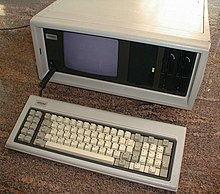
Back حاسوب منقول Arabic Партатыўны кампутар BE-X-OLD বহনযোগ্য কম্পিউটার Bengali/Bangla Portable German Portebla komputilo Esperanto Computadora portable Spanish Ordinateur transportable French Ordinatò portab GCR Portebla komputero IO ポータブルコンピュータ Japanese
This article needs additional citations for verification. (December 2008) |





A portable computer is a computer designed to be easily moved[1] from one place to another, as opposed to those designed to remain stationary at a single location such as desktops and workstations. These computers usually include a display and keyboard that are directly connected to the main case, all sharing a single power plug together, much like later desktop computers called all-in-ones (AIO) that integrate the system's internal components into the same case as the display.[2] In modern usage, a portable computer usually refers to a very light and compact personal computer such as a laptop, subnotebook or handheld PC, while touchscreen-based handheld ("palmtop") devices such as tablet, phablet and smartphone are called mobile devices instead.
The first commercially sold portable computer might be the 20-pound (9.1 kg) MCM/70, released 1974. The next major portables were the 50-pound (23 kg) IBM 5100 (1975), Osborne's 24-pound (11 kg) CP/M-based Osborne 1 (1981) and Compaq's 28-pound (13 kg), advertised as 100% IBM PC compatible Compaq Portable (1983). These luggable computers still required a continuous connection to an external power source;[3] this limitation was later overcome by the laptop computers.[4][3] Laptops were followed by lighter models such as netbooks, so that in the 2000s mobile devices and by 2007 smartphones made the term "portable" rather meaningless. The 2010s introduced wearable computers such as smartwatches.[5]
Portable computers, by their nature, are generally microcomputers.[6] Larger portable computers were commonly known as 'Lunchbox' or 'Luggable' computers. They are also called 'Portable Workstations' or 'Portable PCs'. In Japan they were often called 'Bentocom'. (ベントコン, Bentokon) from "bento".[citation needed]
Portable computers, more narrowly defined, are distinct from desktop replacement computers in that they usually were constructed from full-specification desktop components, and often do not incorporate features associated with laptops or mobile devices. A portable computer in this usage, versus a laptop or other mobile computing device, have a standard motherboard or backplane providing plug-in slots for add-in cards. This allows mission specific cards such as test, A/D, or communication protocol (IEEE-488, 1553) to be installed. Portable computers also provide for more disk storage by using standard disk drives and provide for multiple drives.
- ^ As contrasted with DYSEAC and MOBIDIC, 1950s era military systems which were truck-based/"movable by truck".
- ^ "How to Buy an All-in-One PC". PC Magazine. Retrieved 23 July 2021.
- ^ a b Shanna Freeman (19 September 2012). "What was the first portable computer?".
- ^ "and plug in instead of relying on battery power."
- ^ Petre, Reza Rawassizadeh, Blaine A Price, Marian. "Wearables: Has the Age of Smartwatches Finally Arrived? | January 2015 | Communications of the ACM". cacm.acm.org. Retrieved 2017-05-05.
{{cite web}}: CS1 maint: multiple names: authors list (link) - ^ "What is a Portable Computer? | ACME Portable Machines". Acmeportable.com. 2014-05-23. Archived from the original on 2014-07-07. Retrieved 2014-07-22.
© MMXXIII Rich X Search. We shall prevail. All rights reserved. Rich X Search